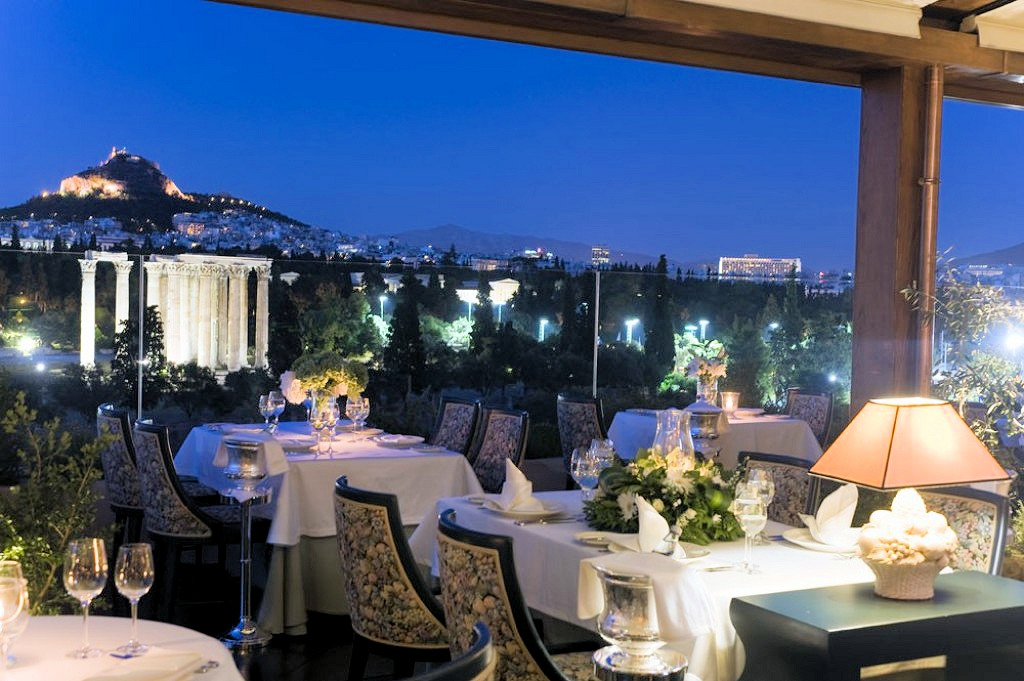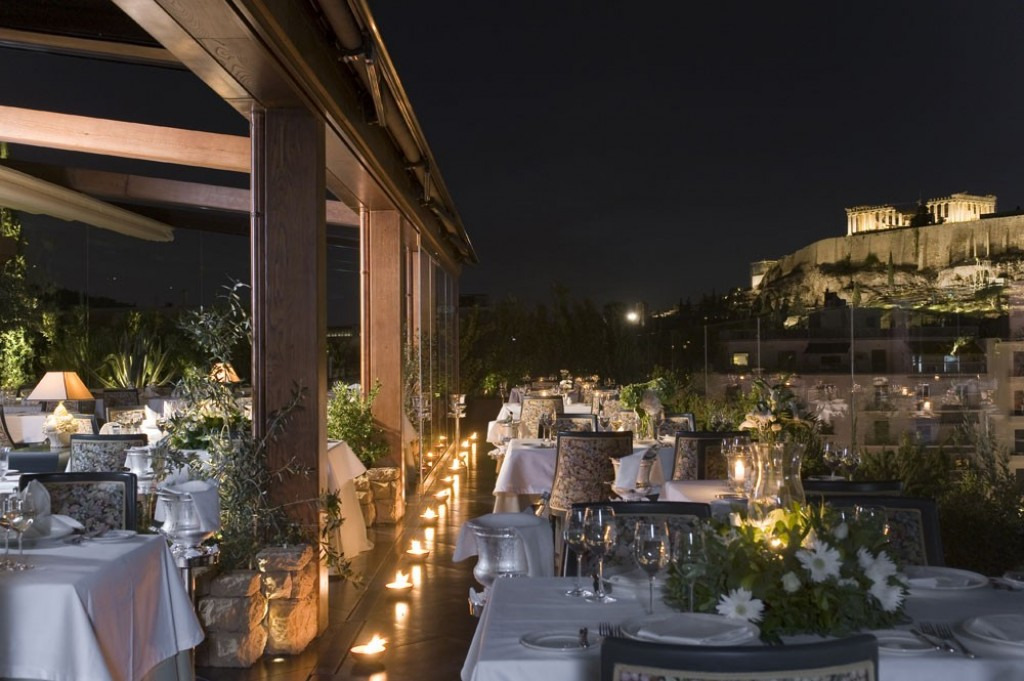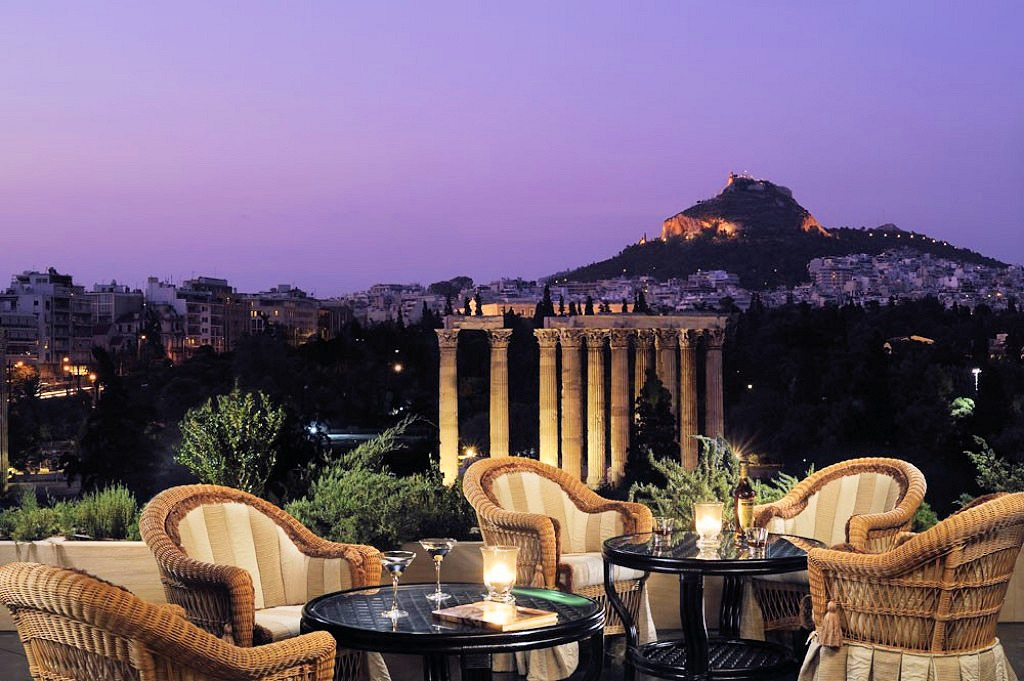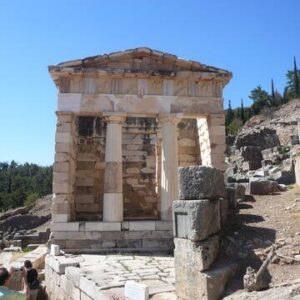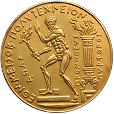Parallel Events
Welcome reception
Monday 28 August 2023, 20:00
The Welcome Reception of RawMat2023 will be held on August 28th, at Peristilion at Zappeion Exhibition hall. All conference participants are invited. Event duration: 20:00 – 22:30Gala dinner
Tuesday 29 August 2023, 20:00
The Gala dinner of RawMat2023 will be held on August 29th, in the restaurant “Ioannis” Roof Garden of Royal Olympic Hotel which is at walking distance (750m, 9min) from Zappeion Exhibition Hall. The restaurant stands on the 7th floor of the hotel with a fantastic view of the Temple of Zeus, the Acropolis, the National Gardens, the Marble Stadium, the Hadrian’s Arch, the Lycabettus Hill, the Parliament, the Old Observatory and the Herodion Theatre. The menu will include creative cuisine from a unique combination of forgotten traditional Greek recipes and modern conception in an impressive presentation.
Field Trip 1 – Guided tour to Aluminium of Greece and Delphi
Thursday 31 August, 08:00 – 19:00
| 08:00 | Departure from Zappeion Megaron |
| 10:30 | Arrival at Aluminium of Greece plant |
| 10:30 – 11:30 | Guided bus tour of Aluminium of Greece/Mytilineos plant Visit of Bauxite Residues valorisation pilot plants |
| 11:30 – 12:30 | Visit of BR disposal site and to the “House of Bauxite” – the enviromental awareness pavilion in Aspra Spitia |
| 12:30 – 13:30 | Light lunch (Cocktail buffet) |
| 13:30 | Departure to Delphi |
| 14:30 – 16:30 | Visit of Delphi Archaeological Site and Museum |
| 19:00 | Return to Athens |
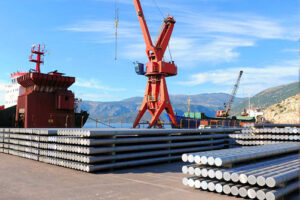
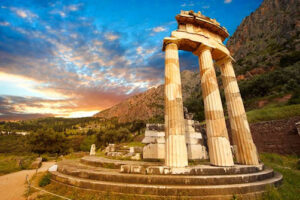
Aluminium of Greece - Mytilineos SA
MYTILINEOS SA is a leader in the Metallurgy industry. Operating the only vertically integrated bauxite, alumina and primary aluminum production unit in all of Europe with privately owned port facilities and the largest electricity cogeneration unit, MYTILINEOS has dynamically entered the sector of recycled aluminum and zinc lead recycling.
“Aluminum of Greece” is the largest vertical producer of aluminum and alumina in the EU and one of the most robust growing industrial companies in Greece. Its international business activity is a driving force for the national economy, but also for the development of the Greek region. It has completed more than 50 years of operation and 15 years of development, with investments that exceed €600 million dedicated on the technological modernization of the facilities and the development of the factory’s production and efficiency. Together with Delphi Distomon, which is the second largest producer of bauxite in Greece and by extension in Europe, annual production exceeds 570,000 tons of bauxite from underground construction sites alone. The company’s focus on sustainability is reinforced by its subsidiary EP.AL.ME, which is the largest independent producer of recycled aluminum (recast).
MYTILINEOS aluminium plant is one of the strongest pillars of Greek industry and has established itself as one of the strongest players in the Metallurgy sector in the European Union, with an annual production capacity that exceeds 190,000 tons of aluminium and 860,000 tons of alumina, following the Bayer and Hall-Héroult methods for alumina and aluminium production respectively (https://www.mytilineos.com/what-we-do/metallurgy-sector/). A large amount of Bauxite Residues (BRs) are annual produced which are mainly disposed of in an adjacent to plant area (dry-stacking). There are several methods investigated for their valorization. Two pilot plants have been constructed for the hydrometallurgical recovery of Sc and REEs and pyrometallurgical treatment in EAFs for metal recovery, which will be visited.
Archeological Site of Delphi
 The pan-Hellenic sanctuary of Delphi, where the oracle of Apollo, the Olympian god of light, knowledge and harmony, spoke, was the site of the omphalos, the ‘navel of the world’. Blending harmoniously with the superb landscape and charged with sacred meaning, Delphi in the 6th century B.C. was indeed the religious centre and symbol of unity of the ancient Greek world.
The pan-Hellenic sanctuary of Delphi, where the oracle of Apollo, the Olympian god of light, knowledge and harmony, spoke, was the site of the omphalos, the ‘navel of the world’. Blending harmoniously with the superb landscape and charged with sacred meaning, Delphi in the 6th century B.C. was indeed the religious centre and symbol of unity of the ancient Greek world.
The development of the sanctuary and oracle began in the 8th century BC, and their religious and political influence over the whole of Greece increased in the 6th century BC. At the same time, their fame and prestige spread throughout the whole of the then known world, from which pilgrims came to the site to receive an oracle from the Pythia, the priestess of Apollo. A place with a rich intangible heritage, Delphi was the centre of the world (omphalos) in the eyes of the ancient Greeks: according to myth, it was the meeting point of two eagles released by Zeus, one to the East and one in the West. The magnificent monumental complex is a human-made environment in perfect harmony with the rare natural environment, the principal features of which gave rise to the organisation of the cults. This harmonious relationship, which has remained undisturbed from ancient times to the present day, makes Delphi a unique monument and a priceless legacy bequeathed by the ancient Greek world to following generations (Source: Unesco-World Heritage Convention).
When approaching Delphi the first site to be seen is the Temenos of Athena Pronaia, the epithet meaning the goddess worshipped before the temple of Apollo. In this sanctuary is situated the renowned Tholos of Delphi, a 4th century BC masterpiece of the ancient Greek architecture. The tholoi were circular structures, attributed to the cult of heroes or chthonic deities, an interpretation that remains uncertain in lack of ancient testimonies regarding their use.
Behind the grounds of Pronaia is the Sanctuary of Apollo. The roughness of the amphitheatrical landscape betrays the most difficult challenge that ancient craftsmen dealt with. A winding path, the Sacred Way led to the imposing Temple of Apollo, that overlooks the shrine from its centrally located, elevated position. In the adyton of this temple, a separate closed room at the rear, Pythia, seated on the tripod, uttered the prophetic – and by all accounts unintelligible – words of the god. The Doric temple seen today was completed in 330 BC, during the reign of Alexander the Great, and it was the last in a succession of six temples built on the site in honour of Apollo.
The elegant Treasuries (Thisavroi in Greek) were erected by several Greek cities to host their votive offerings to the shrine. A notable example in terms of its elegant architecture and sculptural decoration is the 6th century BC treasury of the Siphnians, the oldest structure in mainland Greece entirely built by marble. The Athenians’ treasury was erected after their victory at Marathon in 490 BC to host the best part of their war booty. In the 3rd century BC were inscribed on the outside walls two hymns to Apollo, including the ancient musical signs, an extremely rare finding. Perched on a hillside with panoramic view, lies the theatre of Delphi, built in 400 BC of white stone from Parnassus. Its capacity is estimated to 5000 spectators and it bears all the typical architectural features of the Late Classical Greek theatres, though it is somewhat narrower in form, due to the limited natural space available. In the theatre were held the music and dramatic competitions of the Pythian Games; moreover, the theatre, as the place of public gatherings par excellence, was used for the disclosure of release acts, concerning in their vast majority slaves.
Higher still, a path leads from the theatre to the stadium, where the sporting events of the Pythian Games were held. The stadium acquired its final form during the 5th century BC and was able to hold 7000 spectators (Source: Greek Travel pages).
Delphi Archaeological museum is one of the principal museums of Greece and one of the most visited. The Archaeological Museum of Delphi reveals through hundreds of exhibits the history of the Delphi sanctuary, the most important site of ancient Greece. The rich collections of Delphi museum consist of beautiful marble statues, sculpture works, coins and other finds from that time. The permanent exhibition covers over a thousand years, from the Mycenaean era to the Greco-Roman times. Among sacred treasures, a few of the collection’s most celebrated pieces include the Omphalos (a sculpture is a Hellenistic or Roman representation of the Archaic omphalos kept in in the temple’s inner sanctum, the adyton), the chryselephantine statues 6th century BC, the Kouroi 610 BC, the Sphynx of Naxos 560 BC, the Apollo Kylix 6th century BC, the Charioteer of Delphi 478 – 474 BC, the Statue of Antinoos 130 AD (Source: https://greekcitytimes.com)
Field Trip 2 – Guided tour to Lavrion and Sounion
Friday 01 September, 08:00 – 18:15
| 08:00 | Departure from Zappeion Megaron |
| 09:00 – 10:00 | Visit of Archaeological Site of Thorikos (restored beneficiation plant, ancient theater) |
| 10:00 – 11:30 | Tour at the Lavrion Technological and Cultural Park facilities |
| 11:30 – 12:30 | Lavrion mineralogical museum |
| 12:30 – 13:30 | Archaeological Site of Souriza (Drymos) |
| 13:30 – 15:00 | Lunch |
| 15:00 – 16:30 | Archaeological Site of Sounion – Temple of Poseidon |
| 18:15 | Return to Athens |

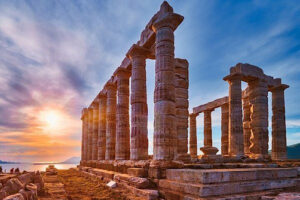
Short History of Mining and Metallurgy in Lavrion
Lavrion’s history has been tightly bound to the history of Greece since prehistoric times. It is a unique historical city in Greece where mining and metallurgical activities (from as early as 3200 BC) mainly focusing on silver extraction, that was used to finance the formidable navy used to defeat the Persians in the naval battle of Salamis, and helped spawn the Athenian empire of the Classical era.
It is situated at the Southeast corner of Attica (60 km from Athens). The entire area of Lavreotiki is metalliferous. Up to 770 different minerals can be found in the Lavrion’s deposit. Worldwide, the Lavreotiki area is considered to be a natural museum of minerals. During antiquity the Athenians developed advanced mining and metallurgical techniques to mine the silver-containing Pb ores, either oxides or sulphides, and produce Ag. The lead content of the ores was in general quite low, it varied with the location and extracting Ag from Pb was considered to be one of the most difficult metallurgical tasks. The main use of Ag in those times was the production of coins, a symbol of welfare and power, and also production of jewellery and silverware. Apart from silver, important quantities of Pb were also produced during the 5th and 4th centuries BC. The decline of the activities began the 3rd century, and during 1st century all activities in the area were halted. The revival of the area began with the independence of Greece in the 19th century for the exploitation of ancient mining, mineral processing and metallurgical wastes initially and then of new ores for over 100 years until 1989 with the involvement of several different companies. All the mining and metallurgy related activities created serious environmental problems in Lavrion. Huge volumes of mining and metallurgical wastes, containing variable amounts of heavy and toxic metals, such as Pb, Zn, Cd, As, have been generated. The city of Lavrion has been developed around and in some cases on top of these waste stockpiles.
Site Visit Details
Among the oldest ancient demes of Attica, Thorikos was one of the 12 settlements that, according to tradition, took part in the political unification under Athens by Theseus. Due to its proximity to the mines of Lavrion, Thorikos was the mining centre of Lavreotiki region. The site was inhabited from the Neolithic age (ca. 4500 BC) and without interruption until the 1st century BC. The excavations have brought to light part of the prehistoric settlement, as well as an extensive part of the historical deme, namely residential quarters, cemeteries, the theater, and the so-called “industrial quarter”, along with ancient mines. Mine extraction in Thorikos dates back to around 3000 BC.
The most important monuments and architectural remains of the archaeological site are:
- The Theatre
- The Mines
- The Geological sites
- The “Industrial Quarter”
- The Early and Middle Helladic Houses (2900-1600 BC)
- The monumental tholos (vaulted) and chamber tombs of the Mycenaean period
- The Acropolis
- The “Temple of Demeter and Kore (Daughter)”
- The Geometric, Archaic and Classical Cemeteries
Thorikos (Theater and rectangular washery)
2. Lavrion Technological & Cultural Park (LTCP)
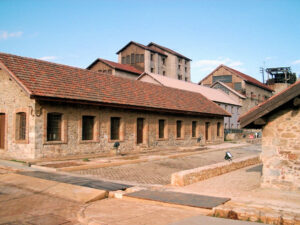 The Lavrion Technological Cultural Park (LTCP) was established in 1992 in the former French Company industrial area when all the mining and metallurgical activities ceased. It was realized with the initiative of the National Technical University of Athens (NTUA) aiming at hosting and promoting research and business activities, as well as protecting and giving prominence to our cultural heritage in a dynamic and sustainable way. LTCP’s facilities include industrial, laboratory and professional premises of high aesthetic and architectural value, which were built mostly during 1875-1940. The Park has been declared as a single listed monument by the Ministry of Culture. Today, most of the industrial buildings have been reconstructed, combining the prominence of their historic form with modern functionality, and LTCP is a unique monument of industrial archaeology and architecture. The realization of the Mining & Metallurgy Museum of Lavrion is in progress with the collaboration of the Ministry of Culture and NTUA, and when completed, it will be a unique museum of its kind at least in national range. Apart from the historical buildings, there are several other relevant interesting places to visit in LTCP including:
The Lavrion Technological Cultural Park (LTCP) was established in 1992 in the former French Company industrial area when all the mining and metallurgical activities ceased. It was realized with the initiative of the National Technical University of Athens (NTUA) aiming at hosting and promoting research and business activities, as well as protecting and giving prominence to our cultural heritage in a dynamic and sustainable way. LTCP’s facilities include industrial, laboratory and professional premises of high aesthetic and architectural value, which were built mostly during 1875-1940. The Park has been declared as a single listed monument by the Ministry of Culture. Today, most of the industrial buildings have been reconstructed, combining the prominence of their historic form with modern functionality, and LTCP is a unique monument of industrial archaeology and architecture. The realization of the Mining & Metallurgy Museum of Lavrion is in progress with the collaboration of the Ministry of Culture and NTUA, and when completed, it will be a unique museum of its kind at least in national range. Apart from the historical buildings, there are several other relevant interesting places to visit in LTCP including:
- The metallurgical plant that operated till 1989.
- The small mining adit
- The landfill for contaminated soils from the LTCP
- The rehabilitated sulphidic tailings disposal site
3. The mineralogical museum of Lavrion
 The museum has been dedicated to the memory of Andreas Cordellas, Greek mineralogist (1836-1909), whose scientific work paved the way to the re-exploitation, in the second half of the 19th century, of the ancient mines of Lavrion. The collection of the Mineralogical Museum of Lavrion comprises samples of minerals from the region of Lavrion, pieces unique both in quality and beauty. More than 610 species of minerals have been discovered in the subsoil of the region (amounting to 16% of the world’s known minerals), which is why the region of Lavrion has been rightly named “an inexhaustible natural mineral and chemical laboratory”
The museum has been dedicated to the memory of Andreas Cordellas, Greek mineralogist (1836-1909), whose scientific work paved the way to the re-exploitation, in the second half of the 19th century, of the ancient mines of Lavrion. The collection of the Mineralogical Museum of Lavrion comprises samples of minerals from the region of Lavrion, pieces unique both in quality and beauty. More than 610 species of minerals have been discovered in the subsoil of the region (amounting to 16% of the world’s known minerals), which is why the region of Lavrion has been rightly named “an inexhaustible natural mineral and chemical laboratory”
4. Archaeological Site of Souriza (Drymos)
The site lies in the northernmost of a series of valleys that stretch to the great valley of Souriza and it was rendered accessible to visitors through a program financed by the European Union and executed by the Hellenic Ministry of Culture. The monuments of the site are:
- Mining wells
- Mineral processing workshops
Sophisticated methods for the separation of lead and silver containing heavy minerals from the light gangue material using rectangular washeries designed to collect, clean and recirculate almost the entire quantity of process water, with sealed with litharge mortars basins, ponds and cisterns, had been applied in Sourisa. In the west part there exists a big subterranean reservoir for drinking water, and on the slope at the NW a rectangular war tower, on top of a preexisting workshop. The tower is most probably connected to the effort of the Athenians to protect the area after the slaves of the mines escaped (413 BC) during the Peloponnesian War. In the east part, at the confluence with the great valley, extends a big cemetery plundered in the past.
5. Archaeological Site of Sounion – Temple of Poseidon
“Sounion, the sacred point of the Athenians (Odyssey, c 278)”
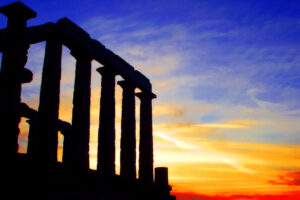 It is one of the most visited sites in Greece known mainly for the white marble Temple of Poseidon and the magnificent view of the sunset. Homer testifies to the sacredness of the area at least from the 8th century BC. In the archaic period (7th- 6th centuries BC) the sanctuary was thriving, though lacking monumental arrangement. Plenty of votive objects were found buried in depositors, gathered there following the destruction of the sanctuary by the Persians in 480 BC. At the end of the archaic period construction of a monumental temple of limestone began, which was destroyed by the Persians before being completed. The temple was rebuilt on the foundations of the previous one around 444-440 BC. In the classical and Hellenistic times (5th – 2nd centuries BC) the sanctuary was frequently visited and a four-yearly festival was organized, officials sailing there in a sacred ship, as in the sanctuary on Delos Island. In later years, the sanctuary was abandoned and the temple gradually decayed.
It is one of the most visited sites in Greece known mainly for the white marble Temple of Poseidon and the magnificent view of the sunset. Homer testifies to the sacredness of the area at least from the 8th century BC. In the archaic period (7th- 6th centuries BC) the sanctuary was thriving, though lacking monumental arrangement. Plenty of votive objects were found buried in depositors, gathered there following the destruction of the sanctuary by the Persians in 480 BC. At the end of the archaic period construction of a monumental temple of limestone began, which was destroyed by the Persians before being completed. The temple was rebuilt on the foundations of the previous one around 444-440 BC. In the classical and Hellenistic times (5th – 2nd centuries BC) the sanctuary was frequently visited and a four-yearly festival was organized, officials sailing there in a sacred ship, as in the sanctuary on Delos Island. In later years, the sanctuary was abandoned and the temple gradually decayed.
The buildings of the archaeological site are the following:
- The temple of Poseidon
- The fortress – the wall
- The settlement
- The port and ship sheds
- The sanctuary of Athena
- The depositor
- The precinct of “Phrontis”, the helmsman in Menelaus’ ship during the return from Troy to Sparta
(http://odysseus.culture.gr by Dr Eleni Andrikou, archaeologist)
Address
Prof. Anthimos Xenidis,
School of Mining & Metallurgical Engineering, Zografou Campus, 9, Iroon Polytechniou str,
15780, Athens, Greece
Phone
+30 697 8800991

